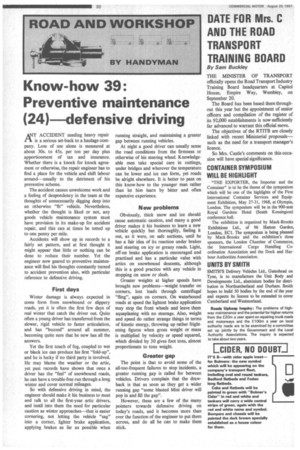Know-how 39: Preventive maintenance (24)—defensive driving
Page 32

If you've noticed an error in this article please click here to report it so we can fix it.
AlY ACCIDENT needing heavy repair is a serious set-back to a haulage company. Loss of use alone is measured at about 30s. to 45s. per ton per day plus apportionment of tax and insurance. Whether there is a knock for knock agreement or otherwise, the repair engineer has to find a place for the vehicle and shift labour
around usually to the detriment of his preventive scheme.
The accident causes unwelcome work and a feeling of despondency in the team at the thoughts of unnecessarily digging deep into an otherwise "fit" vehicle. Nevertheless, whether the thought is liked or not, any goods vehicle maintenance system must have provision in its make-up for accident repair, and this can at times be totted up to one penny per mile.
Accidents will show up in records to a fairly set pattern, and at first thought it might appear that little or nothing can be done to reduce their number. Yet the engineer now geared to preventive maintenance will find his thoughts constantly turned to accident prevention also, with particular reference to defensive driving.
First days
Winter damage is always expected in some form from snowbound or slippery roads, yet it is often the first few days of real winter that catch the driver out. Quite often a young driver has transferred from the slower, rigid vehicle to faster articulation, and has "buzzed" around all summer, becoming quite sure that he now has all the answers.
Yet the first touch of fog, coupled to wet or black ice can produce his first "fold-up", and he is lucky if no third party is involved. He may blame the weather or the artic, yet past records have shown that once a driver has the "feel" of snowbound roads, he can have a trouble-free run through a long winter and cover normal mileages.
So with defensive driving in mind, the engineer should make it his business to meet and talk to all the first-year &tie drivers, and instil into them the need for particular caution as winter approaches that is easier cornering, not letting the vehicle "sag" into a corner, lighter brake application, applying brakes as far as possible when running straight, and maintaining a greater gap between running vehicles.
At night a good driver can usually sense the road conditions from the firmness or otherwise of his steering wheel. Knowledgeable men take special care in cuttings, under bridges and wherever the temperature can be lower and ice can form, yet roads be alright elsewhere. It is better to pass OD this know-how to the younger man rather than let him learn by bitter and often expensive experience.
New problems
Obviously, thick snow and ice should cause automatic caution, and many a good driver makes it his business to learn a new vehicle quickly but thoroughly, feeling it out, as it were, on safe sections, until he has a fair idea of its reaction under brakes and steering on icy or greasy roads. Light, off-on brake application is encouraged and practised and has a particular value with artics on snowbound descents, although this is a good practice with any vehicle in stopping on snow or slush.
Greater weights at higher speeds have brought new problems weight transfer on corners, lost loads through centrifugal "fling", again on corners. On waterbound roads at speed the lightest brake application may stop the front wheels and leave them aquaplaning with no steerage. Also, weight and speed do rather strange things in terms of kinetic energy, throwing up rather frightening figures when gross weight or mass is multiplied by velocity or speed squared, which divided by 30 gives foot tons, almost proportionate to tons weight.
Greater gap
The point is that to avoid some of the all-too-frequent failures to stop incidents, a greater running gap is called for between vehicles. Drivers complain that the drawback is that as soon as they get a wider running gap "some blasted Mini driver will pop in and fill the gap".
However, these are a few of the many pointers towards defensive driving on today's roads, and it becomes more than ever the function of the engineer to put them across, and do all he can to make them stick.












































































































